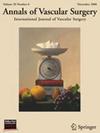静脉流出量和静脉容量在预测急性髂股静脉血栓药物力学溶栓后血栓后综合征中的作用。
IF 1.4
4区 医学
Q3 PERIPHERAL VASCULAR DISEASE
引用次数: 0
摘要
背景:我们旨在评估血流动力学参数在预测药物力学溶栓后急性髂股深静脉血栓形成(DVT)后血栓形成综合征(PTS)发展中的影响。方法:回顾性病例对照研究急性深静脉血栓患者59例,采用药物力学溶栓治疗,根据血栓后综合征的发展情况分为两组;分为血栓后综合征组(n=18)和非血栓后综合征组(n=41)。比较两组患者的基本人口学和临床特征,以及临床和血流动力学评估评分,包括静脉容量和流出量,使用应变计静脉闭塞容积描记仪测量。结果:两组患者在基本人口学及临床特征方面无显著差异。两组在术前临床和血流动力学评估评分方面具有统计学上的相似性。然而,与非血栓后综合征组相比,血栓后综合征组在术后随访中静脉流出的平均值明显降低,而静脉容量的平均值明显升高。和24。个月。结论:本研究表明,静脉流出量和静脉容量在预测急性髂股静脉血栓形成患者进行药物力学溶栓时血栓后综合征的发展方面具有重要作用。本文章由计算机程序翻译,如有差异,请以英文原文为准。
The Role of Venous Outflow and Venous Capacity in Predicting Postthrombotic Syndrome following Pharmacomechanical Thrombolysis for Acute Iliofemoral Vein Thrombosis
Background
We aimed to evaluate the impact of hemodynamic parameters in predicting the development of postthrombotic syndrome following acute iliofemoral deep vein thrombosis (DVT) after pharmacomechanical thrombolysis.
Methods
A total of 59 patients with acute DVT undergoing pharmacomechanical thrombolysis were included in this retrospective case-control study and divided into 2 groups according to the development of postthrombotic syndrome; as postthrombotic syndrome group (n = 18) and nonpostthrombotic syndrome group (n = 41). The groups were compared in terms of basic demographic and clinical characteristics, as well as clinical and hemodynamic assessment scores, including venous capacity (Vc) and outflow measured using strain-gauge venous occlusion plethysmography.
Results
There were no significant differences between the groups in terms of basic demographic and clinical characteristics. The groups were statistically similar in terms of preprocedural clinical and hemodynamic assessment scores. However, compared to nonpostthrombotic syndrome group, in postthrombotic syndrome group the mean values of venous outflow (Vo) were significantly lower whereas the mean values of Vc were significantly higher in postprocedural follows at 6 and 24 months.
Conclusion
The present study demonstrated the critical role of Vo and Vc for predicting the development of postthrombotic syndrome in patients with acute iliofemoral vein thrombosis undergoing pharmacomechanical thrombolysis.
求助全文
通过发布文献求助,成功后即可免费获取论文全文。
去求助
来源期刊
CiteScore
3.00
自引率
13.30%
发文量
603
审稿时长
50 days
期刊介绍:
Annals of Vascular Surgery, published eight times a year, invites original manuscripts reporting clinical and experimental work in vascular surgery for peer review. Articles may be submitted for the following sections of the journal:
Clinical Research (reports of clinical series, new drug or medical device trials)
Basic Science Research (new investigations, experimental work)
Case Reports (reports on a limited series of patients)
General Reviews (scholarly review of the existing literature on a relevant topic)
Developments in Endovascular and Endoscopic Surgery
Selected Techniques (technical maneuvers)
Historical Notes (interesting vignettes from the early days of vascular surgery)
Editorials/Correspondence

 求助内容:
求助内容: 应助结果提醒方式:
应助结果提醒方式:


